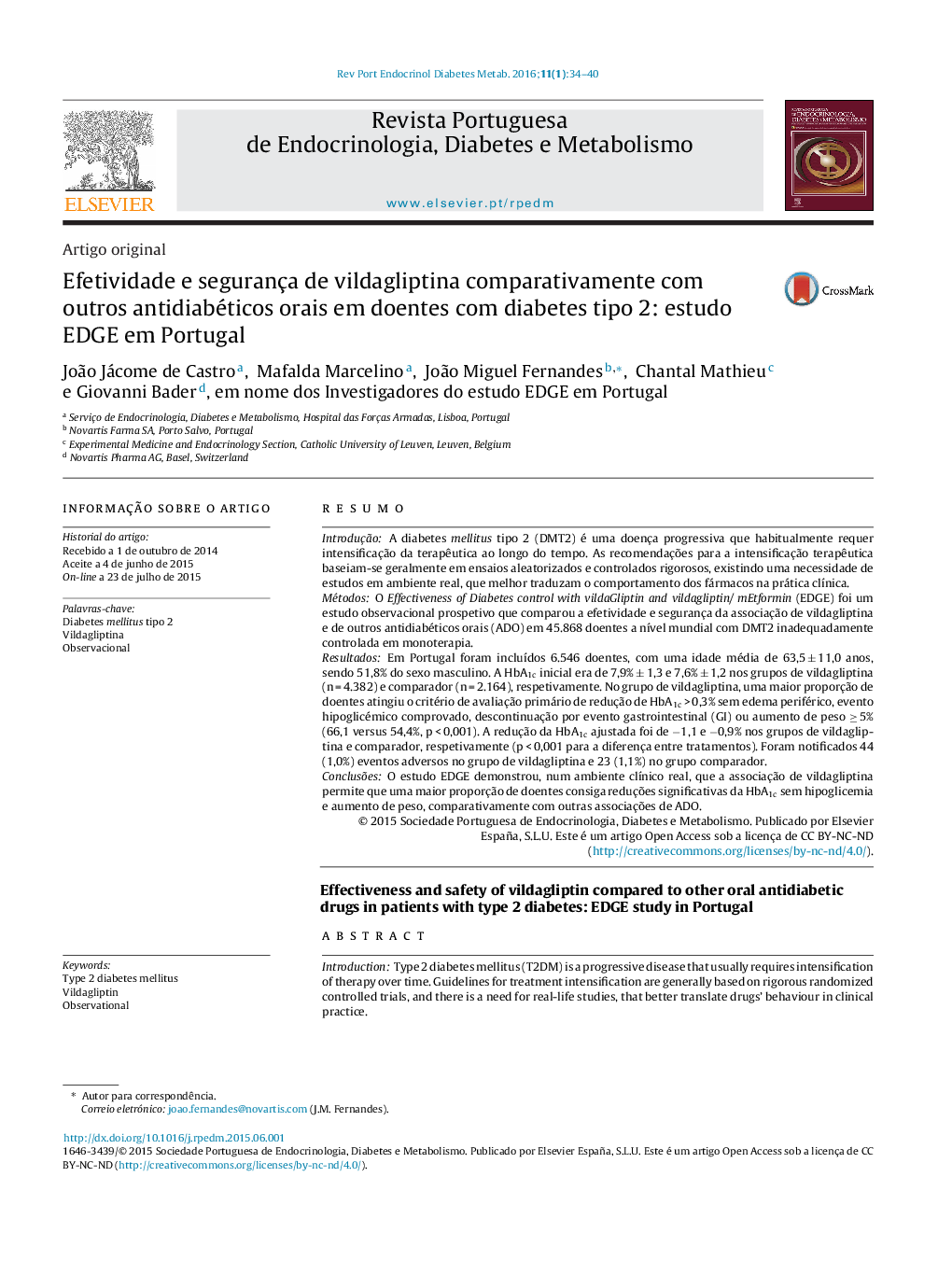| کد مقاله | کد نشریه | سال انتشار | مقاله انگلیسی | نسخه تمام متن |
|---|---|---|---|---|
| 3278225 | 1208782 | 2016 | 7 صفحه PDF | دانلود رایگان |

ResumoIntroduçãoA diabetes mellitus tipo 2 (DMT2) é uma doença progressiva que habitualmente requer intensificação da terapêutica ao longo do tempo. As recomendações para a intensificação terapêutica baseiam‐se geralmente em ensaios aleatorizados e controlados rigorosos, existindo uma necessidade de estudos em ambiente real, que melhor traduzam o comportamento dos fármacos na prática clínica.MétodosO Effectiveness of Diabetes control with vildaGliptin and vildagliptin/ mEtformin (EDGE) foi um estudo observacional prospetivo que comparou a efetividade e segurança da associação de vildagliptina e de outros antidiabéticos orais (ADO) em 45.868 doentes a nível mundial com DMT2 inadequadamente controlada em monoterapia.ResultadosEm Portugal foram incluídos 6.546 doentes, com uma idade média de 63,5 ± 11,0 anos, sendo 51,8% do sexo masculino. A HbA1c inicial era de 7,9% ± 1,3 e 7,6% ± 1,2 nos grupos de vildagliptina (n = 4.382) e comparador (n = 2.164), respetivamente. No grupo de vildagliptina, uma maior proporção de doentes atingiu o critério de avaliação primário de redução de HbA1c > 0,3% sem edema periférico, evento hipoglicémico comprovado, descontinuação por evento gastrointestinal (GI) ou aumento de peso ≥ 5% (66,1 versus 54,4%, p < 0,001). A redução da HbA1c ajustada foi de −1,1 e −0,9% nos grupos de vildagliptina e comparador, respetivamente (p < 0,001 para a diferença entre tratamentos). Foram notificados 44 (1,0%) eventos adversos no grupo de vildagliptina e 23 (1,1%) no grupo comparador.ConclusõesO estudo EDGE demonstrou, num ambiente clínico real, que a associação de vildagliptina permite que uma maior proporção de doentes consiga reduções significativas da HbA1c sem hipoglicemia e aumento de peso, comparativamente com outras associações de ADO.
IntroductionType 2 diabetes mellitus (T2DM) is a progressive disease that usually requires intensification of therapy over time. Guidelines for treatment intensification are generally based on rigorous randomized controlled trials, and there is a need for real‐life studies, that better translate drugs’ behaviour in clinical practice.MethodsEDGE (Effectiveness of Diabetes control with vildaGliptin and vildagliptin/mEtformin) was an observational prospective study that compared the effectiveness and safety of add‐on vildagliptin and other oral antidiabetics (OAD) in 45,868 patients worldwide with T2DM inadequately controlled with monotherapy.ResultsSix thousand five hundred forty‐six patients, with a mean age of 63.5 ± 11.0 years and 51.8% of males were included in Portugal. Baseline HbA1c was 7.9% ± 1.3 and 7.6% ± 1.2 in the vildagliptin (n = 4,382) and comparator (n = 2,164) groups, respectively. In the vildagliptin group, a greater proportion of patients achieved the primary endpoint of HbA1c reduction > 0.3% without peripheral oedema, proven hypoglycaemic event, discontinuation due to a gastrointestinal event, or weight gain ≥ 5% (66.1% versus 54.4%, p < 0.001). The adjusted HbA1c reduction was −1.1% and −0.9% in the vildaglitpin and comparator groups, respectively (p < 0.001 for treatment difference). Adverse events were reported in 44 (1.0%) patients in the vildagliptin group and 23 (1.1%) patients in the comparator group.ConclusionsThe EDGE study showed that in real‐life clinical practice more patients treated with add‐on vildagliptin achieve significant HbA1c reductions without hypoglycaemia and weight gain, compared to other OAD associations.
Journal: Revista Portuguesa de Endocrinologia, Diabetes e Metabolismo - Volume 11, Issue 1, January–June 2016, Pages 34–40